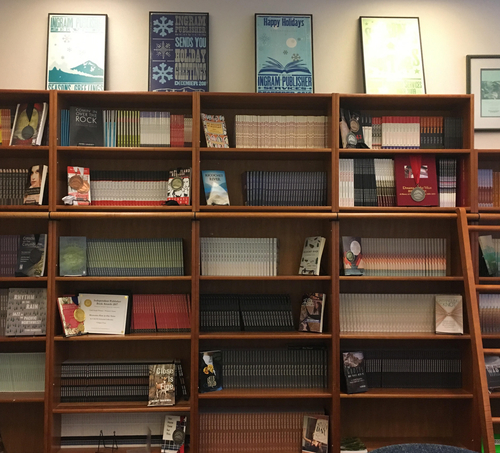As we are settling into our roles as Ooligan’s newest dynamic duo of Publisher’s Assistants, we are beginning to realize that our responsibilities exist very much like an iceberg. Above the water, there’s the work that is more directly tangible—such as running meetings—and underneath the water, there’s all of the work that we do to keep the press operating smoothly, such as archiving.
One perfect example of this dual existence is Ooligan’s inventory. We inherited responsibility over a beautifully organized bookshelf in Ooligan’s main office. This shelf contains titles that are either more recent or more successful, and most Oolies would recognize them. However, we also inherited the keys to the basement, which holds all of Ooligan’s inventory. This is a room that is typically only used by the PAs; we quietly manage the inventory and report back to the Publisher. Although the task of managing the greater inventory downstairs might not sound as appealing as organizing the most Instagram-worthy shelfie upstairs, our unique responsibility is already providing us with a newfound perspective on the press that we are supporting.
For instance, did you know that Ooligan began its journey with a collection of translated stories centered in Croatia, called Zagreb, Exit South? One of three titles in what was styled “A New Croatia,” this first book (long out of print) lives in the far back corner of the basement shelves.
Several years and shelves of book boxes later, Ooligan’s Pacific Northwest focus becomes more pronounced in Sid Miller’s Dot-to-Dot Oregon, seven series of poems marking seven routes through every part of the state, from Baker City to Coos Bay, The Dalles to Klamath Falls. Miller’s poems paint scenes ranging from the intimate experience of an old-fashioned pharmacy in downtown Grants Pass to the sweeping horizon visible from the top of the Oregon Dunes. It’s the kind of book that transports you from the floor of a fluorescent-lit storage room to the eclectic and awe-inspiring beauty of the place in which we live.
On the opposite side of that same shelf, our press shifts into the current decade with stacks of Oregon Stories, one hundred fifty answers to the question, “What does Oregon mean to you?” collected and edited by Ooligan students in honor of the Oregon sesquicentennial in 2010. Featuring a foreword by celebrated Oregon writer Kim Stafford and an introduction by former Governor Ted Kulongoski, these Oregon stories come from writers, public servants, poets, students, and more. Governor Kulongoski even chimes back in for an amusingly relatable tale of the trials and tribulations of hiking the Pacific Crest Trail in Oregon’s many weathers. Full of short and sweet anecdotes and ripe with state nostalgia, Oregon Stories is a classic collection of voices connected by place, time, and the landscapes beautifully collaged together on the cover.
From Oregon Stories, our inventory shelves move into territory more familiar to more recent Oolies: Ruth Tenzer Feldman’s Blue Thread, The Ninth Day, and Seven Stitches; Oolie Kait Heacock’s Siblings and Other Disappointments; and recent award-winners A Series of Small Maneuvers by Eliot Treichel and Memories Flow in Our Veins: Forty Years of Women’s Writing from CALYX. Finally, there are the numerous boxes of our most recent titles, the 25th anniversary edition of Robin Cody’s Oregon coming-of-age classic Ricochet River and Brian K. Friesen’s literary fiction debut, At the Waterline. Where will these books be five years from now? Ten? Imagining shelves of Ooligan books expanding into the future is one of the unsung joys of inventory; what might seem a menial task, unseen and unappreciated, is actually one of the threads that weaves Ooligan Press together, past, present, and future.

